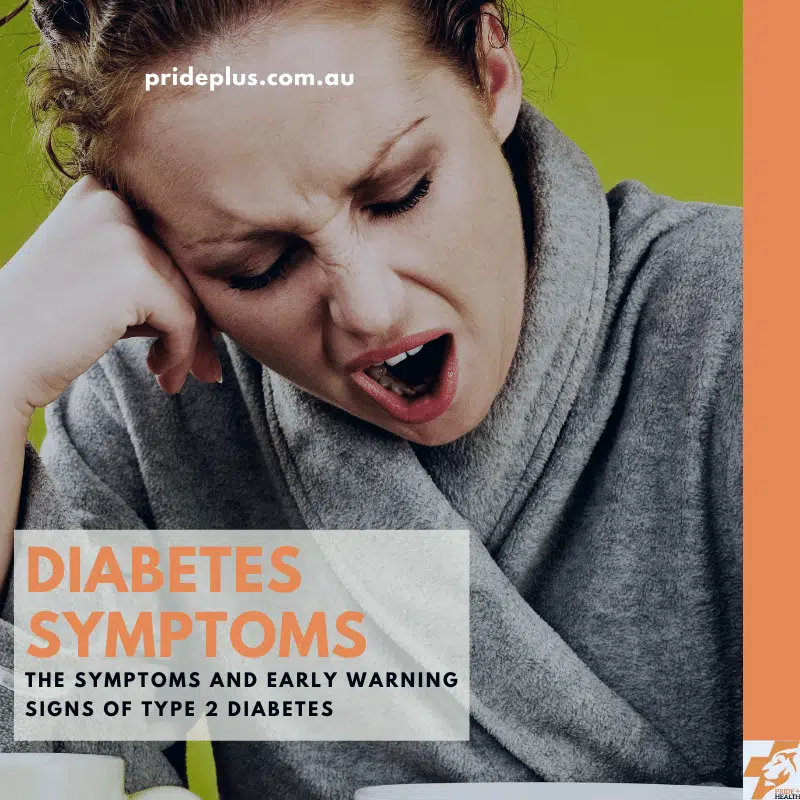Diabetes Type 2 Symptoms and Early Warning Signs
Diabetes type 2 symptoms and warning signs are vital to know. Not just for those of us who have a diagnosis of diabetes. People at risk of type 2 diabetes (that’s pretty much every male in Australia over 50!) should know the symptoms to get onto early treatment.
As an Exercise Physiologist working every day with people with type 2 diabetes these symptoms are something we know well at PridePlus Health.
Let me take you through all that you need and want to know.
Have diabetes? Join the Sugar Burners 🔥 diabetes program.
Lose weight, burn sugar, feel energised.
First, What Is Diabetes
Diabetes is a chronic health condition that is growing in our population.
Diabetes Australia reports that about 280 people are diagnosed with diabetes every day (about one person every five minutes).
All up, there’s around 1.8 million Aussies that have self-reported diabetes right now and surprisingly, they estimate that there’s about 500,000 ‘silent’ cases of undiagnosed diabetes.
Diabetes on the whole is increasing Australia-wide with it growing at a faster rate than other chronic diseases like heart disease and cancer.
Here I will be focusing on type 2 diabetes which accounts for 85-90% of all diabetes cases. For those with gestational diabetes or for most cases of diabetes in children we’ll create some more content shortly.
It’s important to remember that type 2 diabetes is largely preventable if we take the reins early and implement the right lifestyle modifications.
The Most Common Diabetes Type 2 Symptoms
- An unquenchable thirst
- Frequent toilet trips (number ones)
- Feeling tired and lethargic
- Always feeling hungry
- Cuts and scrapes on the skin that take a long time to heal
- Itchy skin prone to infection
- Blurry vision
- Weight gain
- Moody
- Headaches
- Dizziness
- Leg cramps
Feeling Excessively Thirsty and Frequent Urination
One of the most common symptoms of type 2 diabetes and early warning signs are feelings of excessive thirst and frequent urination.
When there’s excessive amounts of glucose (sugar) in your blood, your body tries to find ways to get rid of it. Your kidneys are the main organ for filtration in your body. They do a great job at filtering and absorbing excess glucose, waste and fluids.
However when this process reaches a point where your kidneys can no longer keep up filtering out the high blood glucose levels and some glucose will end up passing into your urine.
The glucose carries some water with it and because you’re passing more fluid, the feeling of dehydration comes on. Your body needs more water, so you drink, causing a cycle that causes you to urinate more frequently.
This can be a cycle of feeling thirsty and urinating frequently which is a symptom to look out for.
Always Feeling Hungry
Another common symptom for people with type 2 diabetes is always feeling hungry. Your body needs fuel (in the form of glucose) to survive and carry out it’s normal operations.
When you don’t have enough fuel in your body you might fall into hypoglycaemia (low blood sugar). Lucky your body is clever and as a response it signals to you that you need food (a source of energy) by bringing on the feeling of hunger.
When you eat the food, your body will quickly break it down into glucose (the sugar in your blood) and it’s readily available for you to use. Your blood sugars will return to normal and you are no longer in a ‘hypo’ and feeling hungry.
There’s also a bunch of symptoms that can indicate low blood sugar like dizziness, headaches, sweating, shaking and inability to concentrate, so look out for those.
Lethargy, Feeling Tired
In the context of diabetes symptoms, 🔽 hypoglycemia AND 🔼 hyperglycemia can both make you feel tired and lethargic.
Where hypoglycemia is the term for low-blood sugar levels (below 4mmol/L), hyperglycemia is the term for high blood sugar levels (above 8mmol/L). If you’re in a ‘hypo’, activities like driving and operating machinery are unsafe. The general rule of thumb is you have to be ‘above 5 to drive’.
So you can feel tired and lethargic from too little fuel in your body and too much. It’s a lot more common that this feeling is from a ‘hypo’ but be aware that it can be both.
Blurred Vision
Blurred vision can happen with fluctuations in blood sugar levels throughout the day. If you’re not already diagnosed with diabetes, this could serve as an early warning sign.
Diabetes can have a big effect on your eye health. It can cause the focusing ability of your eyes to weaken and lead to vision loss from diabetes retinopathy. Diabetes retinopathy occurs when there is damage to the small blood vessels that supply your eye. One major risk factor for this is if your blood glucose levels haven’t been managed well over time.
With blood glucose levels and blood pressure in healthy ranges, diabetic retinopathy can be avoided.
Another eye issue that can develop for people with diabetes is Glaucoma. This is a group of eye conditions that damage the main nerve (the optic nerve) that innervates your eyes. The side of your vision is affected first and this can lead to gradual vision loss, ‘tunnel vision’ and blindness.
Diabetes Australia recommends regular eye checks as these conditions often are found when it’s too late.
Leg Cramps, Skin Infections and Slow Healing of Cuts
Diabetes can cause lots of problems with your legs and feet. Just ask our podiatrists!
If diabetes is left unchecked, it can cause damage to the blood vessels causing poor circulation, nerve damage and heighten the risk of infection, foot ulcers and amputation. These problems are more likely to happen if you’ve had diabetes for a long time, have had high blood glucose levels for a long time, if you’re a smoker and if you’re inactive.
The cramping feeling could possibly be a response to poor blood circulation and damage to nerves of your lower leg. It can also be related to muscle weakness or poor venous return.
When you have diabetes, your ability to heal properly is compromised and on top of that, if you have nerve damage, you may not be able to even feel what is going on. This is pretty dangerous stuff. Most commonly your limbs and extremities are at risk, particularly in places where wounds and infections can go unnoticed (like your feet!).
Diabetes Australia recommends seeing a Podiatrist for routine foot care and performing daily self checks.
Our podiatrists are super passionate about diabetes foot health and love helping you get the most out of your feet. As I’ve heard them say, you only get one pair, so you better look after them.
Kidney Problems
As I mentioned earlier in the article, your kidneys are the organ in your body in charge of filtering your blood. Very small structures inside your kidneys, called nephrons, get this job done. They filter waste and fluid from the bloodstream.
Diabetes can damage these filtering units and lead to kidney disease, diabetic neuropathy and even kidney failure.
The most common warning signs of this are things like frequent urination and blood in your urine.
Again, this is serious stuff and it’s no surprise that Diabetes Australia recommends annual kidney health checks for people living with diabetes.
The Bottom Line
If you’re experiencing any of these symptoms, especially if you have a family history of diabetes, you need to speak to your GP.
If a positive diagnosis of diabetes is found, access the right help in diabetes educators, exercise physiologists, podiatrists and dietitians to assist you with appropriate lifestyle modifications.
Take part in the Sugar Burners 🔥 diabetes program.
Lose weight, burn sugar, feel energised.
FAQ About Diabetes Type 2 Symptoms
Speed Round! These questions come up weekly in our diabetes group exercise classes from both newly diagnosed and those who’ve just started their journey managing their diabetes.
How does diabetes happen?
There are two main causes for diabetes. The first is insulin resistance, the second is an inability to produce insulin.
Insulin resistance
Insulin is the key hormone for allowing glucose to cross from the blood into tissues like muscle, fat and organs. When your body develops resistance to insulin, you will need to produce and release more insulin into your blood to get the desired effect of lowering the amount of glucose in your bloodstream. This will result in more insulin in your blood – a key indicator of the presence of diabetes.
Inability to produce insulin
Your pancreas is the organ that produces insulin. In type 1 diabetes, genetic factors play a role in the complete inability to insulin production. However in type 2 diabetes, the pancreas can get worn out from producing high levels of insulin over a long period of time because of the body’s resistance to insulin. With your body unable to produce insulin, you will need to get it from injections as prescribed by your GP, endocrinologist and diabetes educator.
How do I check myself for diabetes?
There’s a couple of ways to check yourself for diabetes. There’s testing and self monitoring. As the symptoms of diabetes include some things which we can’t intuitively know, your GP and health care team will be vitally important. For example, how do you know you cant feel your feet if you cant feel them? There’s a podiatrist or diabetes educator for that.
Testing
If you’re experiencing any diabetes type 2 symptoms or have a family history of diabetes, your first port of call is to contact your GP.
Your GP will likely ask you about your family history, whether you had diabetes in pregnancy, current lifestyle habits and medical history to get a clear picture of your diabetes risk factors.
Next stop is to take a blood test.
The key diagnostic factor your GP will look at is your HBA1c.
HBA1c gives an accurate representation of what your blood glucose levels have been over about 3-6 months. This is way more accurate for a diabetes diagnosis compared to just testing what your blood sugar levels are at any given time. Think of it as more as an average blood glucose levels measure rather than a single snapshot.
If your HBA1c is over 6.5% you are probably going to get diagnosed with diabetes.
If your HBA1c is under 6.5% but is close to the threshold, you could be told you are in a state of ‘Pre-Diabetes’. This is a place where you at at a high risk of diabetes, but you’re not there yet. There’s still a chance!
Coming back from pre-diabetes is very achievable.
Changes to exercise habits, diet and other lifestyle risk factors like smoking and alcohol consumption can play a huge role in your exit from pre-diabetes and back into the healthy range.
Self-monitoring
If you do find yourself living with diabetes, regularly checking your blood sugar levels is highly recommended for top of the class diabetes management.
It’s important to check so you can make sure you are staying around your normal ranges and to develop an understanding of how different foods and physical activity impact you.
The normal range for your levels of glucose in your blood is between 5-7mmol/L. You can go below and above this but too long at either end can have some implications.
🔽 Below 4mmol/L is hypoglycemia (low blood sugar).
🔼 Above 8mmol/L is hyperglycemia (high blood sugar).
Generally, people living with diabetes will have been given this important information, as well as strategies to combat hypoglycemia and hyperglycemia from their GP, EP, Diabetes Educator. As you can see, appropriately managing diabetes is often a whole team affair.
Can diabetes go away?
Diabetes doesn’t just go away. The diagnosis will stay with you but you can still be healthy and change the things that led to your diagnosis.
For example, if you get diagnosed with diabetes after a HBA1c% of 6.5%, you can absolutely get that number down with healthy lifestyle interventions. On top of that, the symptoms and complications you might be dealing with that are stemming from your diabetes can dissipate and come under control.
Think exercise, diet and weight loss.
In the past it was said that there was no cure for diabetes. This can be really fatalistic to hear… I mean, if there’s no cure? What’s the point?
We now know that many people can go into a form of diabetes remission. Living a healthy life, full of all the wonderful things without being on diabetes medication or regularly checking their blood sugar levels. This is the place we love to get to.
What are the 3 most common symptoms of undiagnosed diabetes?
The 3 most common symptoms of undiagnosed diabetes mellitus are thirst, fatigue and being overweight.
How can you tell if someone has diabetes?
Your GP will be able to tell you if you have diabetes via the blood testing we discussed above. Prior to that there are a number of different indicators that can show how at risk someone is of having diabetes.
In Australia we have the Aus D Risk tool, a simple group of questions that can show just how at risk you are of having and developing diabetes.
Another test is the oral glucose tolerance test which your GP can perform to tell if someone has diabetes.
Can type 2 diabetes symptoms come and go?
As diabetes is a condition where blood sugar levels fluctuate outside of their normal ranges the symptoms can vary wildly and come and go. Eating healthy foods and getting plenty of exercise can help keep undiagnosed diabetes symptoms at bay, but diving into some celebratory birthday cake and alcohol can bring them right on back.
How do you feel when blood sugar is high?
One of the difficult diabetes complications is that with elevated blood sugar levels your mood will change and you can feel different. Everyone is unique but a consistent feeling reported is frustration, moody, angry and quick to temper.
How long can you live with untreated type 2 diabetes?
As diabetes is a progressive condition that can lead to many life ending conditions (heart attack, cardiovascular disease, chronic kidney disease) if left untreated it may not be a long life at all. If you couple that with the severe and quality of life effecting conditions like amputation of feet, loss of vision, eye damage, constant dry mouth getting untreated diabetes treated is imperative.
It’s not a life sentence, the management of type 2 diabetes is an extension of the quality, healthy lives we all strive to live. Getting back on to of your medical conditions, addressing a lack of exercise, having a healthy diet are all vital to preventing the complications of diabetes.
Which organs are affected by diabetes?
All your organs can be affected by diabetes. The kidneys, eyes, heart and brain are all affected earlier than others but they don’t call organs vital for no reason. Any organ that has damage can lead to severe complications of diabetes.
What does undiagnosed type 2 diabetes feel like
For some undiagnosed diabetes will not feel any different. It might be a mild or early case of diabetes or it might be that they have had the symptoms so long they’re used to being hungry, tired, thirsty and angry.
How do I check myself for diabetes?
Run through the checklist at the top of this post. Do you have these symptoms? Get frequent infections? Have a first-degree relative with diabetes? Am I at risk for type 2 diabetes?
If you’re able to answer these in the negative there’s less likelihood that you have diabetes. But diabetes is a diagnosis, and for a diagnosis you need to see a doctor. Like any chronic disease, sit down with your doctor, have a discussion, go through some tests and learn for yourself if you have diabetes or not.
What happens when you are diagnosed with type 2 diabetes?
People with type 2 diabetes are often overwhelmed at first. There’s all these new terms, new health professionals (what even is an EP?). The diagnosis alone is enough to raise your blood pressure when you’re sitting in your doctors office.
All those questions. Do I need insulin injections? What are my insulin-producing cells doing so wrong? Am I going to be taking oral diabetes medications for life?
The first steps after you’ve been diagnosed is to breath deeply, find out about the type of diabetes you’ve been diagnosed with and start piecing together a plan with your health care team.
What colour is diabetic urine?
Your GP or diabetes educator is the best person to discuss this with however if your urine is very dark or if there is blood in your urine you need to get help, fast. Red flag!
What should I eat if my sugar is high?
If you have elevated blood sugars it’s not about what you should eat, but what you should do. Everyone with diabetes needs their own personal plan to know how to safely lower their blood sugar levels. For some this will involve the careful dosing and injecting of insulin.
For others it will involve a burst of activity or exercise.
Blood sugar control is an important part of managing diabetes however there are always outliers. You can have perfect control over blood sugar levels for most of the time but periods of extreme stress, changes to medications or poor access to good food choices can all leave to elevated blood glucose levels.
Can eating too much sugar cause diabetes?
Eating too much sugar for long periods of time places stress on the pancreas to produce a lot of insulin. Too much stress can damage the ability to produce quality insulin and contribute to your increased risk of type 2 diabetes.
Be active, enjoy a varied and healthy diet, maintain a healthy weight and consume sugar sporadically.
Am I going to lose my toes to diabetes?
Blood vessel diseases and damage to the arteries of the legs are a serious complication of both types of diabetes (1 and 2). The risk of damage to blood vessels can be lowered by maintaining the right levels of blood sugar for you. If you want to prevent these complications from diabetes then the lifestyle factors (diet, exercise, activities) are paramount.
If you already have poor circulation from either types of diabetes or maybe you have spent too much time in your younger days cigarette smoking then your podiatrist will be able to help still. Wearing the right socks, shoes and orthotics can all reduce your risk of losing toes to diabetes.
A scary thing to hear can be that diabetes under control can still lead to poor circulation. Your podiatrist will be able to manage this risk down again and keep your toes safe. Working with a multi disciplinary team they’ll keep your feet in good condition.
Does where I was born increase my risk of diabetes?
Some ethnicities are more at risk of developing diabetes. Indigenous Australians, people of Chinese origin, those from the Indian subcontinent or come from Middle Eastern backgrounds are at a greater risk of developing diabetes.
Also, when you were born plays a part too. People aged over 50 are more likely to develop diabetes than those under 50. The risk of diabetes increases as you get older too.
What is the best exercise to manage my diabetes type 2 symptoms?
A combination of aerobic exercise as well as resistance exercise (lifting weights) are important to manage diabetes symptoms. For most increasing your level of physical activity to even moderate exercise levels will be a great start in getting on top of your diabetes and avoiding complications like kidney damage.
The Sugar Burners 🔥 program combines different levels of exercise from high intensity exercise to moderate exercise to breathing exercises. We conduct our sessions in a small group environment so you can enjoy the comradery and community of working together on your own personal but similar goals.
The program is not like other gym programs, it’s not just about body weight. We’ll be working with you, supporting you like the caring health care professional you know and need. The health benefits from joining Sugar Burners 🔥 go above and beyond just managing your diabetes. You’ll be feeling more energised, happy and engaged with the world as your journey continues.




